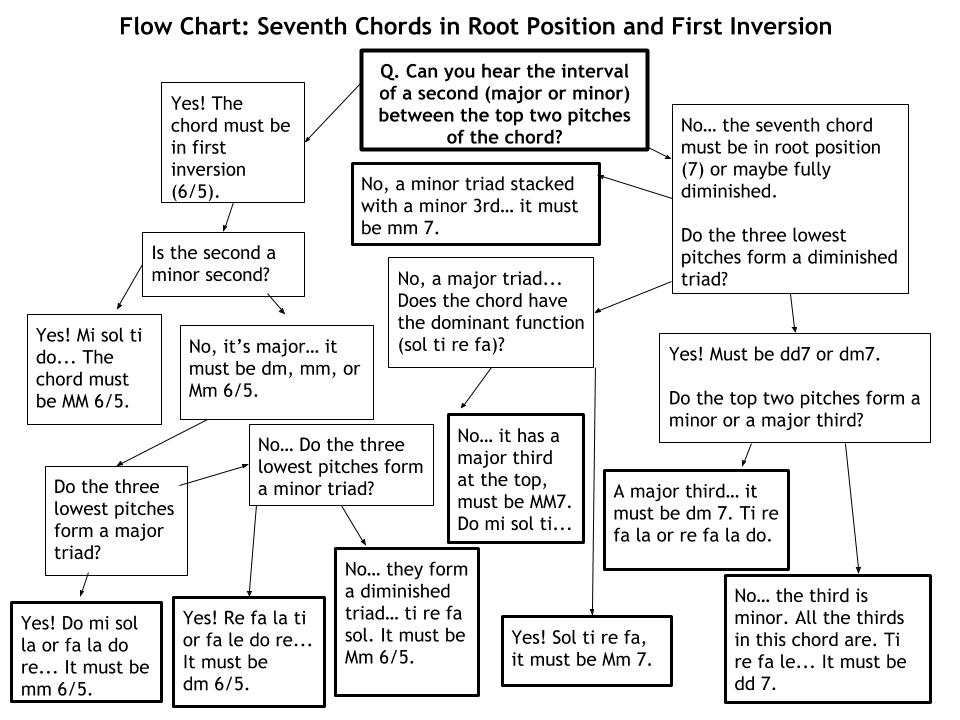Integrated Aural Skills 2018-19
Ear Training - Seventh Chords in All Inversions
In Unit 5, we studied five different types of seventh chords (dd, dm, mm, Mm, MM) in root position, first inversion, and second inversion. In this unit, we will add the third inversion so that you can identify seventh chords in root position and all inversions.
When we notate chords in inversions using figured bass, we abbreviate the intervallic relationships in the chord from lowest to highest pitch using the shorthand in the first table below.
This week we are going to study seventh chords in third inversion, which we notate using the abbreviation 4/2. Please commit this table to memory for easy recall.
| Position | Intervallic Relation | Abbreviation |
|---|---|---|
| Root Position | 1-3-5-7 | 7 |
| First Inversion | 1-3-5-6 | 6/5 |
| Second Inversion** | 1-3-4-6 | 4/3 |
| Third Inversion | 1-2-4-6 | 4/2 |
- You may find the chord quality of 4/2 chords easier to identify than for the other inversions, because they are composed of the interval of a second between the lowest two pitches, stacked with a triad at the top. The quality of the second and of the triad will be determined by the chord quality, but crucially, the triad that makes up the upper three pitches of a 4/2 chord has the same quality as the triad the makes up the lower three pitches of the chord when it appears in in root position.
- Further, the interval of a second that makes up the lowest two pitches of a 4/2 chord is the inverse of the seventh between the lowest and highest pitches of the chord in root position.
Piano and Singing Practice
Please play the following chords in root position and all their inversions on the piano. Sing up and down the notes of the chords using solfege. As you do so, engage three of your learning tools: your visual, auditory, and kinesthetic senses. Ask yourself:
- How do the chords look on the page?
- How do the chords sound? What are their particular coloristic qualities?
- How does it feel to play each chord with your fingers on the piano’s keyboard?
- How does it feel to sing each chord using solfege?

| Chord | dd 4/2 | dm 4/2 | mm 4/2 | Mm 4/2 | MM 4/2 |
|---|---|---|---|---|---|
| intervallic and chordal relation | A2 + diminished triad | M2 + diminished triad | M2 + minor triad | M2 + major triad | m2 + major triad |
| function and solfege | vii0 4/2 in minor - le ti re fa | vii⌀4/2 in major keys, la ti re fa; ii⌀4/2 in minor keys, do re fa le | ii4/2 in major keys, do re fa la; vi4/2 in major keys, sol la do mi. | V 4/2 in major and minor keys: fa sol ti re | IM4/2 in major keys: ti do mi sol |
| salient features | This chord may appear in 4/2 in scores. In this class, always ID it as root position. | Apart from dd 4/2, the only 4/2 chord with a diminished triad. | The only 4/2 chord with a minor triad. | Strong dominant function = could resolve to I6 | The only 4/2 chord with a minor second |
Tips for Easy Identification and Notation
- What are some of the features that only exist in certain chords?
- As always in inverted chords, the minor second is the dead giveaway that the chord quality is MM. Once you identify that interval, don’t waste time thinking about other chord qualities, since it can only be MM. Its position within the chord will give you your inversion. Recall your solfege and use it to notate the chord.
- Only two 4/2 chords have major triads between the three upper pitches. Which ones are they?
- Excluding dd 4/2 for now, only one chord has a diminished triad between the three upper pitches. Which one?
- Two of the chords do not contain the interval of a tritone between any of the tones. Which ones?
- One of the chords contains not one but two tritones! Which one?
- Two of the chords contain just one tritone apiece. Which ones?
- One of the chords contains zero perfect consonances…
- Two of the chords contain not one but two perfect consonances…
- Find your own methods!
Make Your Own Flow Chart
In Unit 4, we shared a flow chart that helped identify seventh chords in root position and first inversion.

This week, why not make your own flow chart to help you identify seventh chords in all the inversions?
- In our flow chart, we suggested the initial question “Can you hear the interval of a second?” You can certainly begin with this question, but try some other ones too.
- “Does this chord have a context in a major key, a minor key, or either?” (Hints: dd = minor only; dm = can be found in different contexts in major and minor; Mm has the same function in major and minor etc.)
- “All seventh chords have dissonances. Do the tones of this seventh chord contain the dissonance of one or more tritones?”
- Find your own method!